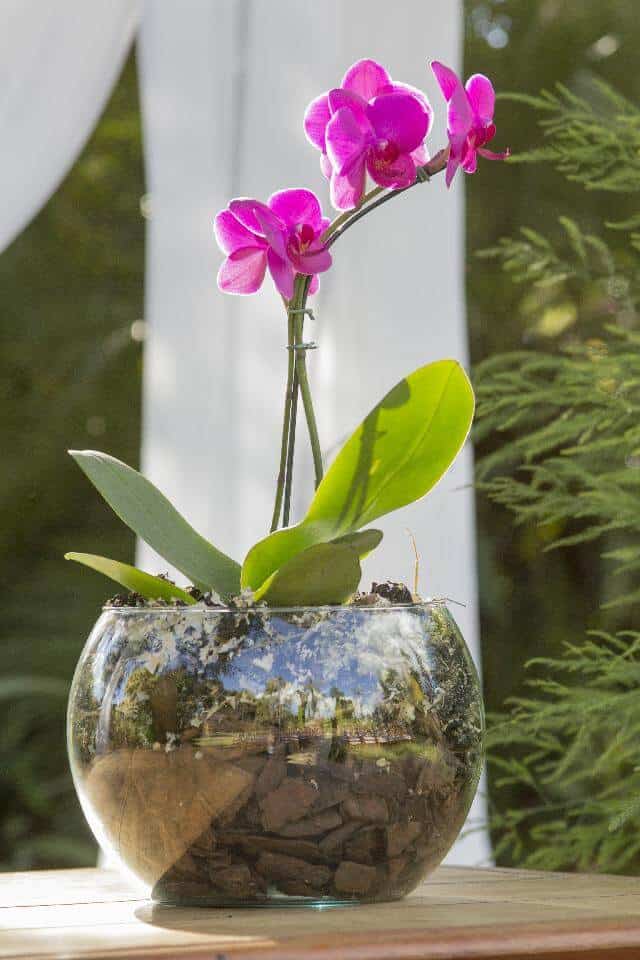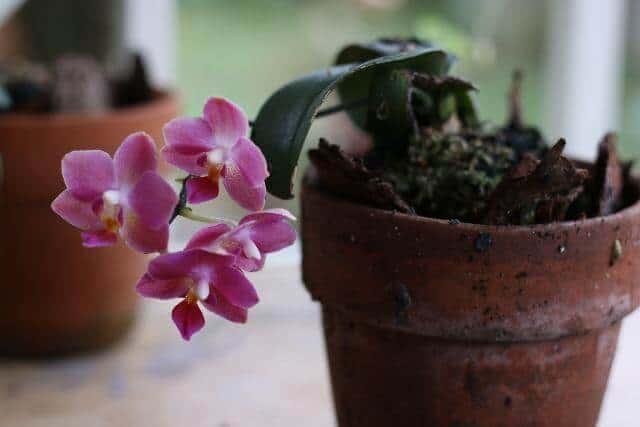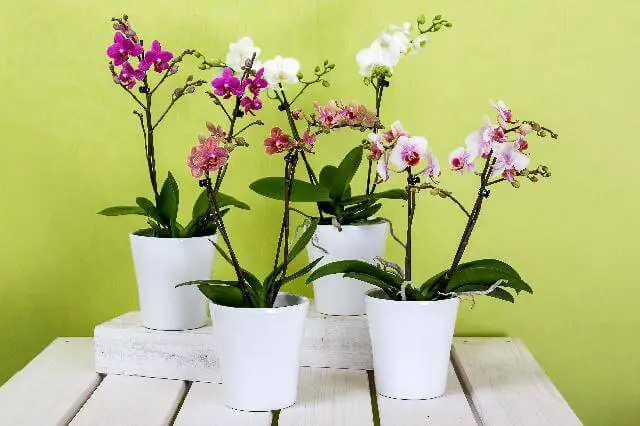Contents
Aerial roots are not so uncommon among orchids. If you weren’t aware, there are two distinct types of orchids. You’ve got the terrestrial orchids and the epiphytic orchids. Terrestrial orchids burrow their roots into the soil, while epiphytic orchids have roots that shoot upwards into the air. Hence the name, aerial or air roots.
If you are familiar with Phalaenopsis orchids and any other epiphyte orchid, you’ll even consider these aerial roots to be a regular part of the plant. Moreso, they are easily identifiable. All those roots that you find above the growing medium of your orchid plant are air roots.
Unlike other epiphytic air plants that you know of, epiphytic orchids are not parasitic. They use their air roots to absorb nutrients from the air rather than from the plants they attach themselves to. They are pretty harmless as they do not penetrate the branches of the plants they attach themselves to. Their only similarity to other epiphytic plants is that they use their aerial roots to attach themselves to the branches of other plants. This helps them grow high enough for them to reach spaces with adequate sunlight.

Good to Read: How to Prune an Avocado Tree in a Pot
Repotting Orchids With Aerial Roots
This repotting process is not much different from when you repot any other plants. However, the step-by-step guide outlined below will make this an easy process to follow.
Step #1 – Remove the Plant From Its Pot
First, you’ll have to remove the orchid plant from its old pot without damaging any of its roots. In the process, you might discover that some of the roots have been attached to the pot and may get damaged in the process. Try to minimize any chances of this occurring as much as you can because if there’s a lot of damage, there is a good chance that the plant will not survive.

Step #2 – Remove the Old Potting Medium
Shake off the old potting mix from the roots. Once you have gotten most of it out, you can either throw it away or compost it. Whatever you do with it, don’t reuse it. When shaking off the potting mix from the roots, be careful once again not to damage the roots.
Step #3 – Rinse Away the Leftovers
The next step is to rinse the leftover old medium by running some room-temperature water over the orchid air roots. If the leftover soil mix has become a clump around the roots, soak the roots in a bowl of water for a couple of minutes and shake off the leftover soil mix in the bowl of water.
Step #4 – Sort Through the Roots
Once all of the potting mixes have been removed, you can now clearly identify the roots. It is easy to distinguish the healthy roots from the old, dead roots. Once you discover the dead, old roots, cut them off using a sterilized scissor.
Step #5 – Sterilize Those Roots
After sorting through the roots and removing all of the dead matter, you’ll have to sterilize the orchid roots. Make use of 3% hydrogen peroxide because a stronger peroxide concentration will kill your plant. Or you could make use of cinnamon.
Step #6 – Choosing the Orchid Pot
If you plan to use the current container to replant your orchid, maybe because the entire plant still fits into it, then you must ensure that you clean and sterilize it as well. However, if you’re considering a new planting pot, you only have to consider two distinct criteria: the size of the pot and the type of pot.
Clay pots are well-draining and offer perfect temperatures to grow orchids. Plastic pots come in various exciting designs to complement your home. Whichever you choose, ensure that it is a larger pot size that can hold up both the roots and the rest of the plant without tipping over.

Step #7 – Choosing the New Medium
When planting orchids, you can use a mix of both inorganic and organic matters, or you could buy any orchid potting mix available in your grocery store. Try to use a mixture of clay pellets, coconut fiber, coconut husk, pieces of bark, sphagnum moss, and lava rocks as they are well-draining, providing a humid environment for orchid growth. Essentially this new potting mix will perform better than regular potting mixes.
Step #8 – Repotting
Now that you’ve got your bark mix and your special pot, it is time to replant. To do this, hold your orchid in the middle of the pot and fill it up with the potting mix. Again, keep the copious aerial roots above ground so that they can thrive.
Step #9 – Watering
Now, we’ve gotten to the last step. It also doubles as the most important step, watering. Wait a week before watering your newly planted orchid. To discover how to do this properly, follow any of the watering methods discussed below.
Good to Read: How to Grow Fig Tree Indoors
How to Correctly Water Orchids
Did you know that watering your orchids incorrectly is the major cause of death of indoor orchids? Rather than leave you to experiment with so many inaccurate watering techniques, here are some tried and true tips that’ll keep your orchids vibrant throughout their entire life cycle.
Tip #1 – Water From the Top
It is best to water your orchids from the top down in a spray bottle filled with lukewarm water. For orchids with pseudobulbs, i.e., the enlargement biologically designed for water storage, touch the potting mix to determine if it is getting dry. When dry, water from the top down using a spray bottle. For orchids without the enlargement, water only when the potting mix is slightly damp.
Tip #2 – Do Not Use Ice Cubes
A lot of articles might tell you to water your orchids with ice cubes instead to prevent overwatering. I’ll have you know that this tip is false and can lead to underwatering instead. In addition, freezing temperatures obtained from ice cubes aren’t conducive or friendly to orchid growth because they are primarily tropical plants and will prefer tepid water.
Tip #3 – Watering in Sphagnum Moss
The major problem associated with watering orchids planted in sphagnum moss is root rot. Sphagnum moss, as a potting medium, is very absorbent. Therefore, it retains much water at its inner core, leaving the orchid’s roots constantly wet.
To grow orchids in sphagnum moss, pot them by wrapping their roots around a Wiffle ball. After that, you wrap sphagnum moss around the roots. Then, to water, you can soak the roots in water without worrying about the development of root rot.
Tip #4 – Watering in Bark
The bark is majorly used as a potting medium because it is well-draining. So, there are fewer chances of the development of rotten roots in the orchid’s root system. To water orchids planted in a bark-based potting mix, you either do it from the top, or you do it from below.
To water from above, fill a spray bottle with water and spray the orchid without soaking its crown. Watering using this method helps to get rid of fertilizer salts present in your potting mix.
To water from below, place the orchid in a pot filled with water. This method protects the crown, the most susceptible to rot, from getting soaked up in the water. This method also keeps the leaves of orchids dry. This prevents the growth of bacteria on those leaves.
Good to Read: Growing & Propagating Rosemary From Cuttings – Here’s How?
When to Water Orchids and When to Hold Off
Now that you’ve learned a few tricks on watering your orchids correctly, let us delve into when you ought to water them. How do you know that your orchid doesn’t have enough water to survive? For both new and old-timer orchid growers, these tips will help:
Tip #1 – Perform a Finger Test
This is relatively self-explanatory. Either stick a finger, chopstick, or toothpick into the potting medium at the top of the pot and leave for a brief couple of minutes. Then, take out your finger, toothpick, or chopstick and check for any visible signs of wetness. If there is no sign of wetness, then you should most definitely water your orchid plant.
Tip #2 – Check Out the Drainage Holes
If you planted your orchids in one of those clear pots, you know those clear plastic pots encased in a more decorative pot, you can look at the drainage holes for any signs of dampness. You could also poke through the drainage holes using a toothpick to confirm wetness. If it is totally dry, then it is undoubtedly time to water.
Tip #3 – Water Early in the Morning
The time of the day when you water your orchids matters. The morning is an appropriate and suitable time as it leaves enough windows for the crown to dry off before nighttime. This helps prevent rot from occurring.

Good to Read: How to Prune Knockout Roses after First Bloom
Orchid Care: Caring for Aerial Roots
Identifying Healthy Roots: Healthy orchid roots are usually identified by sight and feel. They feel firm and could range in colors from white to green. The roots of new orchids are characterized by their green tips. As the new plant matures, a white protective substance coats it. This means that firm, white roots are nothing to worry about because they indicate healthiness.
Importance of Humidity: You should grow indoor orchids in areas with high humidity. When grown in areas with low humidity, the plant’s roots begin to yellow and wither. To increase humidity levels around the orchid, you can turn on a cool-mist humidifier in your home. Try to ensure that the humidity level in your home environment does not pass 50 percent.
Immediately you notice the yellow, withering roots, get a sterilized cutting tool such as a pair of scissors or knife and use it to cut away the roots only when the entire plant stops blooming.
Implications of Overwatering: If your orchid’s roots remain bright green for long periods, it could be an indication that they are drowning due to overwatering. Eventually, these roots will rot, turning hollow, brown, and mushy in the process. This will ultimately kill your orchid.
Implications of Underwatering: When you notice the roots becoming brittle, it indicates that the plant is underwatered. Although, sometimes, looks can be deceiving. Whenever you see the roots getting brittle, touch the potting media to check out their dampness levels. If it is damp to the touch, do not water the plant. If it is not damp, mist the roots.
Related Questions
What Kind of Pot Will Be Great for My Orchid?
When choosing a special pot for your orchid, you’ve got to consider three factors. One, the size of the pot. Two, the potting material. Three, the style and decor. Factors one and two are the most important as they contribute significantly to you growing a healthy orchid.
Once you’ve made a decision, other thoughts to consider are the drainage holes. Always ensure that it has enough drainage holes because orchid roots do not like water.
How Do I Know When It’s Time to RRepotMy Orchid?
It would help if you only repotted once the roots have overgrown their current pot. This usually happens once every 1-2 years. Other reasons to repot are if the potting mix isn’t well-draining, your orchid has outgrown its container, or if the potting media smells terrible. When repotting, choose a new pot at least an inch larger than the previous pot.
How Can I Water Moth Orchids in Bloom?
You know it’s that time of the year when gorgeous blooms appear on your orchid. How you water during this season relies heavily on the orchid species. Naturally, you might assume that since orchids have tropical forests as their natural habitat, overwatering won’t be a problem, but as we’ve established throughout this article, it might be. For orchids like Dendrobiums, it is best to let them dry out before watering. However, moth orchids prefer to be kept evenly moist. For best results, let the water condensation on the sides of the orchid pot be absorbed before watering.
As orchid lovers, it is important to treat orchids with care as we transplant them to their new homes. Lots of gentle handling will ensure that healthy orchid roots survive at the bottom of the pot. A sure sign of new growth after repotting will be the appearance of new roots at the base of the orchid bark.
Want to know more about gardening ?
Fill in your email address in the form below and you'll receive all the latest updates directly in your in-box.
Thank you for subscribing.
Something went wrong.